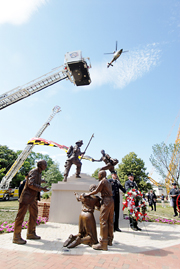Heroes Among Us
Meet them at Maryland’s Fallen Firefighters Memorial in Annapolis
by Ben Miller
Dial 911 and we expect a response. Police, firefighters or an ambulance, we count on them — and they show up.
As was once said about the U.S. Lifesaving Service, these people have to go out. They don’t have to come back. Some don’t. They never rejoin their families. They never say goodbye.
A new memorial in Annapolis, dedicated June 11, remembers the 376 Maryland firefighters and emergency workers who have gone out and not come back. It also remembers the families they left behind.
Reading the Statues
In sculptural styles, the monumental and symbolic — long favored in our land of heroes — is giving way to the human and realistic.
These real people, cast in bronze sculpture, don’t brag about their great deeds of the past. They give us messages for the future from beyond their earthly forms.
At City Dock, storyteller Alex Haley beguiles children with the trials and adventures of his ancestors mixed with solid lessons on how these young people can live their lives.
At Lawyers’ Mall/State House Square off of State Circle, the young Thurgood Marshall wields the weapon of American justice to fight for the promise of a future of equal opportunities for young men and women.
Now on the corner of Rowe Boulevard and Bladen and Calvert streets, bronze sculptures of a firefighter and an emergency worker send a message of love and service. They say goodbye to their families for the last time in that split second of death as they die doing their duties.
The male firefighter and the female emergency technician are turning as they ascend. They seem to pause to wave goodbye to sculptures of an older man, a woman and a boy.
This is a moment caught in time. It is also a fluid moment. The firefighter and the emergency worker will continue to rise. They are going and will not come back. The figures left behind are stationary, but not frozen. They will continue to mourn those who are leaving.
Feeling the Statues
Rodney Carroll of Baltimore designed and sculpted the figures.
“This is a place to say goodbye for those who never had a chance, to reach back to loved ones,” he said at the dedication. The event drew an audience of some 1,500, mostly uniformed firefighters and their families, as well as Gov. Robert Ehrlich, Lt. Gov. Michael Steele and Senate President Mike Miller.
“We have all lost someone with whom we never had the chance to say goodbye,” Carroll explained. For him, his father.
The sense of family is a palpable part of this sculptural group, even though it doesn’t represent a literal family but a symbolic one. We can see ourselves a part of this family, if only in empathy.
As with the Haley memorial, you can walk up to these figures. They are there to be touched. Families can mingle among them. Those of us still here can merge with those who exist only in bronze.
An effective work of art sends many messages. This one does.
The memorial stands in a surrounding plaza of bricks, some inscribed with the names of donors, and a wall inscribed with the names of the 376 people who have died in the line of duty. It’s a place that calls forth the pride, tradition and courage that are part of the firefighting and emergency service traditions.
The memorial also speaks of the family feeling among firefighters, emergency workers, and those who love and support them.
Others will see the memorial and recall the sacrifices of the wide circle of people — family, friends and colleagues — who are touched when someone dies.
There is room on the memorial plaques for many more names. People have died since the planning for this memorial began. There is a message there, too. More will die.
But memorials can be about the future as well as the past. As Alex Haley’s message is that we cannot treat people as his ancestors were treated, as Thurgood Marshall’s message is that we cannot deny opportunity to people as was done in the past, so too this memorial has a message. These statues want us to reflect on how the diligent application of training and safety precautions can reduce the number of people who die while serving the community and ourselves.
The memorial was a project of the Maryland Fire-Rescue Services Foundation built at a cost of $850,000. Money was raised through private donations, including the sale of inscribed bricks in the plaza, and with contributions from the state of Maryland.
The Maryland Fallen Firefighters Memorial is best visited by parking in the Gotts Court parking garage behind the Annapolis Visitors’ Center and walking down Northwest Street toward Calvert Street. Turn right on Calvert Street. The memorial is across Calvert Street from the Louis L. Goldstein statue in front of the Goldstein Treasury Building.
Bay Weekly museum and monument critic Ben Miller planned exhibits for the National Park Service from Alaska to the Virgin Islands for 32 years, with a hand in the making of more than 100 exhibits. He’s visited hundreds more museums and has also worked in historic preservation in his long-time home, Jefferson County, West Virginia, including both Harpers Ferry and Shepherdstown.